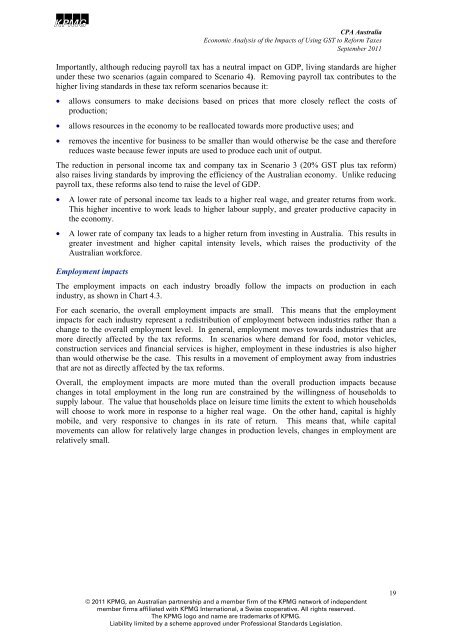kpmg-econtech-final
kpmg-econtech-final
kpmg-econtech-final
- No tags were found...
You also want an ePaper? Increase the reach of your titles
YUMPU automatically turns print PDFs into web optimized ePapers that Google loves.
ABCDCPA AustraliaEconomic Analysis of the Impacts of Using GST to Reform TaxesSeptember 2011Importantly, although reducing payroll tax has a neutral impact on GDP, living standards are higherunder these two scenarios (again compared to Scenario 4). Removing payroll tax contributes to thehigher living standards in these tax reform scenarios because it:• allows consumers to make decisions based on prices that more closely reflect the costs ofproduction;• allows resources in the economy to be reallocated towards more productive uses; and• removes the incentive for business to be smaller than would otherwise be the case and thereforereduces waste because fewer inputs are used to produce each unit of output.The reduction in personal income tax and company tax in Scenario 3 (20% GST plus tax reform)also raises living standards by improving the efficiency of the Australian economy. Unlike reducingpayroll tax, these reforms also tend to raise the level of GDP.• A lower rate of personal income tax leads to a higher real wage, and greater returns from work.This higher incentive to work leads to higher labour supply, and greater productive capacity inthe economy.• A lower rate of company tax leads to a higher return from investing in Australia. This results ingreater investment and higher capital intensity levels, which raises the productivity of theAustralian workforce.Employment impactsThe employment impacts on each industry broadly follow the impacts on production in eachindustry, as shown in Chart 4.3.For each scenario, the overall employment impacts are small. This means that the employmentimpacts for each industry represent a redistribution of employment between industries rather than achange to the overall employment level. In general, employment moves towards industries that aremore directly affected by the tax reforms. In scenarios where demand for food, motor vehicles,construction services and financial services is higher, employment in these industries is also higherthan would otherwise be the case. This results in a movement of employment away from industriesthat are not as directly affected by the tax reforms.Overall, the employment impacts are more muted than the overall production impacts becausechanges in total employment in the long run are constrained by the willingness of households tosupply labour. The value that households place on leisure time limits the extent to which householdswill choose to work more in response to a higher real wage. On the other hand, capital is highlymobile, and very responsive to changes in its rate of return. This means that, while capitalmovements can allow for relatively large changes in production levels, changes in employment arerelatively small.© 2011 KPMG, an Australian partnership and a member firm of the KPMG network of independentmember firms affiliated with KPMG International, a Swiss cooperative. All rights reserved.The KPMG logo and name are trademarks of KPMG.Liability limited by a scheme approved under Professional Standards Legislation.19



